by Briscoe White | Feb 22, 2011 | Basics, Gardening, Growing, Herbs, Inspiration, Miscellaneous |
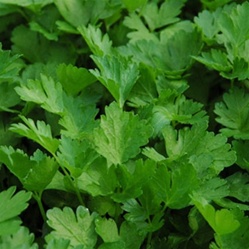
Italian Flat Leaf Parsley
Happy Parsley Day! On February 22nd, we take time to honor a much loved culinary and medicinal herb that packs a punch of flavor! An herb, a spice AND a vegetable all in one plant, this dynamic herb is a key component in many cuisines like Middle Eastern and Spanish, but is most distinctly known in Italian dishes. Parsley symbolizes love, protection and purification and throughout history has been a sign of honor and class. Ancient Greeks used Parsley to honor champions of sporting events, and it was also used in wreaths and sprinkled on the dead. The word “Parsley” is derived from the Greek word meaning “rocks or stones”, which reflects the terrain Parsley is native to. They believed that Parsley grew in the spot where the mythological hero Archemorus was slain.
The two main varieties, Italian Flat Leaf and Curly, are adored for different reasons. While some believe the Flat Leaf is easier to grow, it is the quintessential Parsley for cooking, as it has a more flavorful taste. The soft, crinkled look of the Curly Parsley makes it a great garnish and it is used to enhance many gourmet dishes with its beauty. Also a necessary component to the favorable herbal combination, Bouquet Garni, Parsley tastes terrific with hearty dishes like potatoes, stews, lamb, lasagna or rice.
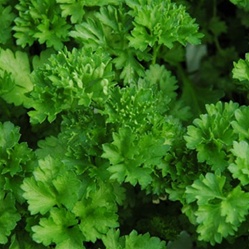
Curly Parsley
Medicinally, Parsley has a long history of being associated with women’s health. An emmenagouge, it was often used to start the menstrual cycle, but should not be consumed in great quantity by pregnant women. Parsley also contains elements that help the body absorb Manganese much more efficiently, an important mineral for strengthening bones. When paired with dishes that contain high zinc or copper-rich foods, it helps retain these bone-improving vitamins and minerals much more thoroughly. When applied directly to insect bites, it is also said to soothe the itching or stinging sensation!
A great companion plant, Parsley attracts insects, diverting their attention from other garden growers. Plant Parsley near your tomatoes to draw the attention of pesky tomato hornworms, moths and flies away from your veggies. Parsley thrives in full sun, with moist, well-drained soil, but because of its tough seed coat, it can often be hard to germinate from seed. If germination actually does occur, it should only take four to six weeks to see sprouts peeking through the soil. Superstition says that the reason that Parsley takes so long to germinate is because it has to travel to Hell and back seven times before sprouting. Though we aren’t sure where this delightful herb got such a bad rap, we assure you, it’s been growing safe and sound in our greenhouse!
by Kenan White | Feb 17, 2011 | Miscellaneous |
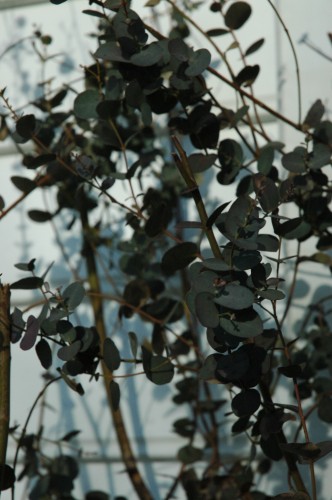
We have included Eucalyptus ‘Silver Drop’ in our selection of herb plants for the past twenty years. The plants are started from seed about six months before they are ready to sell. Eventually growing into a small tree or shrub, they provide excellent stems of silvery foliage for use in cut flower arrangements. Not only beautiful, it is long lasting and aromatic. Eucalyptus also dries well for use in dried arrangements. As useful as it is beautiful, Eucalyptus is also a great decongestant. This herb’s the full package- a lovely aromatic herb for arrangements and landscaping which is also a useful medicinal herb as well!
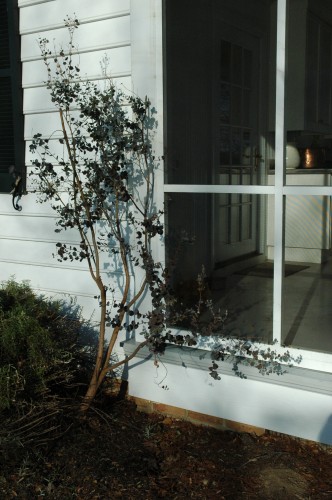
Having sent several hundred little plants out into the world we often wonder what became of them. Around town there are a few large specimens grown from our starter plants. Here is a picture of one that is cut each summer and still makes a nice landscape plant. And even though they are rated for hardiness zones 9-10, they do not seem bothered in the least by our zone 7 winters. (Even as hard as this past one has been!) We just love to see our plants growing strong and healthy after leaving our greenhouse. It’s a great feeling to know that something you’ve nurtured is continuing to bring others joy as it grows!
by Briscoe White | Feb 17, 2011 | Herbs, Life on the Farm, Miscellaneous, Wildlife |
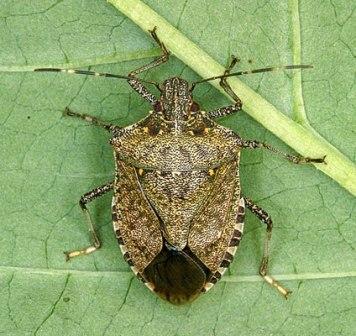
For many of us on the East Coast (particularly MD, DC and VA), this time of year not only marks the first warm weeks which hint of the coming spring season; it means to prepare for the invasion. It’s not a terrorist or nuclear threat we’re talking about…it’s something far smellier: stinkbugs. In 2010 our region suffered a swarm of these foul little pests and as we begin seeing warmer weather in this (hopefully) early spring, they are beginning to settle in like unwanted house guests.
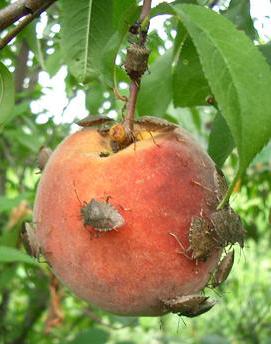
Though they don’t bite or sting, they do emit a pretty putrid odor when crushed, smooshed, vacuumed up, or squished, and though they are more of an annoyance for homeowners, local farmers are beginning to fret. Stinkbugs prey on crops like raspberries, tomatoes, peaches and other fruits, sucking the juices out of them and leaving them undesirable. Especially in the organic farming community, who strive not to use harmful pesticides, concern is on the rise. So, what is your best line of garden defense against these pungent perpetrators? The all natural answer is herbs!
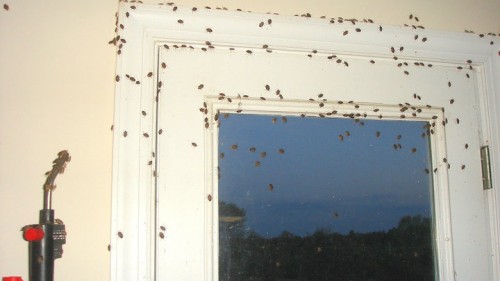
Don't let this happen to your home!
Strongly scented herbs such as Mint, Lavender, Catnip, and Patchouli have been proven to thwart the little stinkers from overwhelming you favorite fruits and veggies. (It’s hard to believe that they are picky about smells…I guess everyone likes their own brand!) You can also try planting other natural insect deterrents around your home or garden like Tansy, ‘Citronella’ Scented Geraniums, Pyrethrums and Rue to keep the bugs at bay. For the insidious insects that have already made it indoors, try making sachets with some of these herbs or use their essential oils to coat your window sills and thresholds. This will hopefully keep the rest of the stinkbugs from sneaking in and joining their friends inside your nice warm home. You can also fill jars with soapy water to catch the critters that have already begun to show up indoors, as the soap will dissolve their exoskeleton, killing them in a non-toxic way.
In conjunction with February being National Bird Feeding Month, try attracting birds to your garden with feeders, houses and baths, to keep your bug problem to a minimum. We’ve heard that blue jays are fond of these stinky little snacks, so encourage them and other seed-eating friends to nest around your yard to prevent the problem from getting out of hand. Bats also find stink bugs to be a delicacy, so place bat boxes throughout your yard and near the garden to help battle the bugs.
by Herb Exchange | Feb 15, 2011 | Inspiration, Miscellaneous, Recipes |

Chimichurri Steak
Our resident Chef and Office Manager, Julie discovered a great recipe over the weekend using fresh herbs. The fresher, the better!
There are so many herbs in our greenhouse to choose from that I can go on a culinary adventure any day of the week. On Friday, I chose to put a little Latin flair into my weekend by whipping up a delicious Argentinean chimichurri sauce with fresh ‘Italian Flat Leaf’ Parsley, ‘English’ Thyme, and ‘Greek’ Oregano that I got right here at The Growers Exchange. This recipe was super simple but packed a world of flavor when drizzled over my perfectly grilled steak!!
Chimichurri (you can use a food processor or chop by hand):
1 1/2 cup Spanish olive oil
Juice of 2 limes
1 1/2 cup finely chopped fresh ‘Italian Flat Leaf’ Parsley
8 cloves garlic, finely chopped
1 shallot, minced
1 Tbsp each finely chopped fresh ‘English’ Thyme and ‘Greek’ Oregano
Salt and pepper to taste
Instructions:
Combine the ingredients in a bowl and season with salt and pepper. Or, place the herbs, shallots and salt & pepper into a food processor. Pulse until fine, then drizzle the olive oil down the shoot while pulsing and until you get your desired texture. Divide the chimichurri between 2 bowls. Use half as the marinade and half as the dipping sauce.
Steak:
2 lb skirt steak
Chimichurri
Salt and pepper
Instructions:
1. Place the steak in a large baking dish and pour half of the chimichurri over it. Turn to coat; cover and marinate in the refrigerator for 2 hours.
2. Preheat grill to high. Let the steak come to room temperature. Remove it from the marinade and season with salt and pepper. Grill for 4 to 5 minutes on one side until browned, turn, and grill another 4 to 5 minutes for medium-rare doneness. Remove from the grill, let the meat rest for 10 minutes, and slice thinly on the bias. Serve with the remaining chimichurri on the side
by Briscoe White | Feb 14, 2011 | Flowers, Gardening, Growing, Inspiration, Life on the Farm, Miscellaneous |
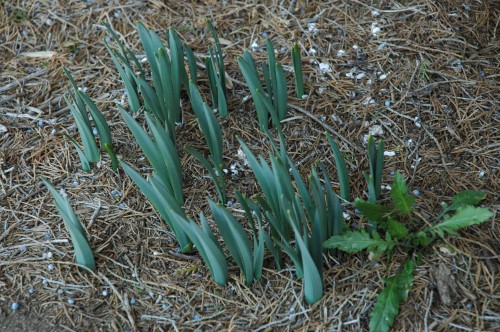
Daffodils are a sure sign of spring!
Every year that we have been blogging, I get to a time in early February when I begin searching for signs of spring. Most of this searching goes on close to the ground because the blustery winter wind does not feel like spring. But even with the frigid temperatures, I know some plants have begun to get ready for a break in the weather.
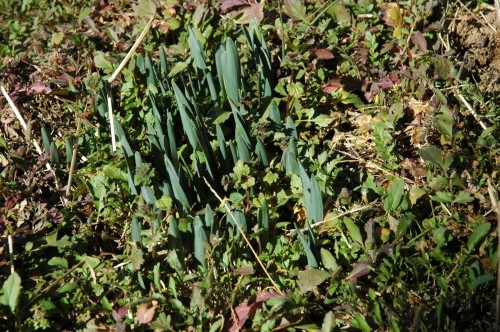
Spring has sprung on the farm!
The most reliable harbingers are the bulbs. Crocus and snowdrops are usually the first spring growth sighted, followed by the early varieties of daffodils. But this year was a little different, and it was a clump of honeysuckle that showed me the first plant growth of spring. After a more thorough investigation, I went looking around the farm and sure enough; bulbs had emerged from the ground! I am not refuting anything the groundhog said, because we do have weeks of cold weather ahead (in spite of the sixty degree weather we’re having this week in central Virginia). But the difference now is that we know spring has begun and it is only a matter of time before the ground thaws and that first warm breeze sweeps through your garden!
by Herb Exchange | Feb 11, 2011 | Gardening, Growing, Herbs, Indoor Gardening, Inspiration, Miscellaneous, Urban Gardening |
Since we recently posted on our Social Media and Marketing Director, Caroline’s Nasturtiums that went to seed, there has been an exciting development! Read her update below for the news…
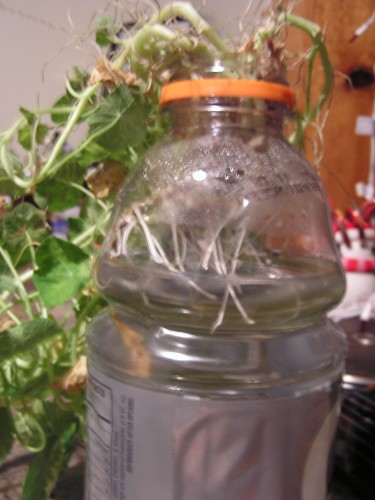
My severed Nasturtium actually started sprouting little, white roots!
Well, when repotting my ‘Alaska Mix’ and ‘Empress of India’ Nasturtiums recently, I accidentally broke off a beautiful, healthy stem that had a ton of marbled foliage trailing from it. Worried that I had just ruined one of the prettiest branches of the plant, I immediately started to look around for a solution. With the speed of an ER nurse, I placed the severed “appendage” in the first thing I could find and fill with water–an empty Gatorade bottle. After filling the bottle with cold water and jamming the wounded end of my favorite plant down into the neck of the bottle so that it was just under the water level, I left my crippled Nasturtium to recuperate in a sunny spot. I had honestly forgotten that it was even there, and figured that maybe it was only staying green because it was freshly cut, and, much like a bouquet of cut flowers, it would wilt and become compost in a week or so. Much to my surprise when I happened to take a look at it last night, the lonely, broken stem had started to put out lots of little, white volunteer roots, each stretching down into the water. Amazed that my accidental pruning had resulted in another Nasturtium plant, I just had to share! The moral of my story is that even trial and error in gardening can grow to be a great experience!











